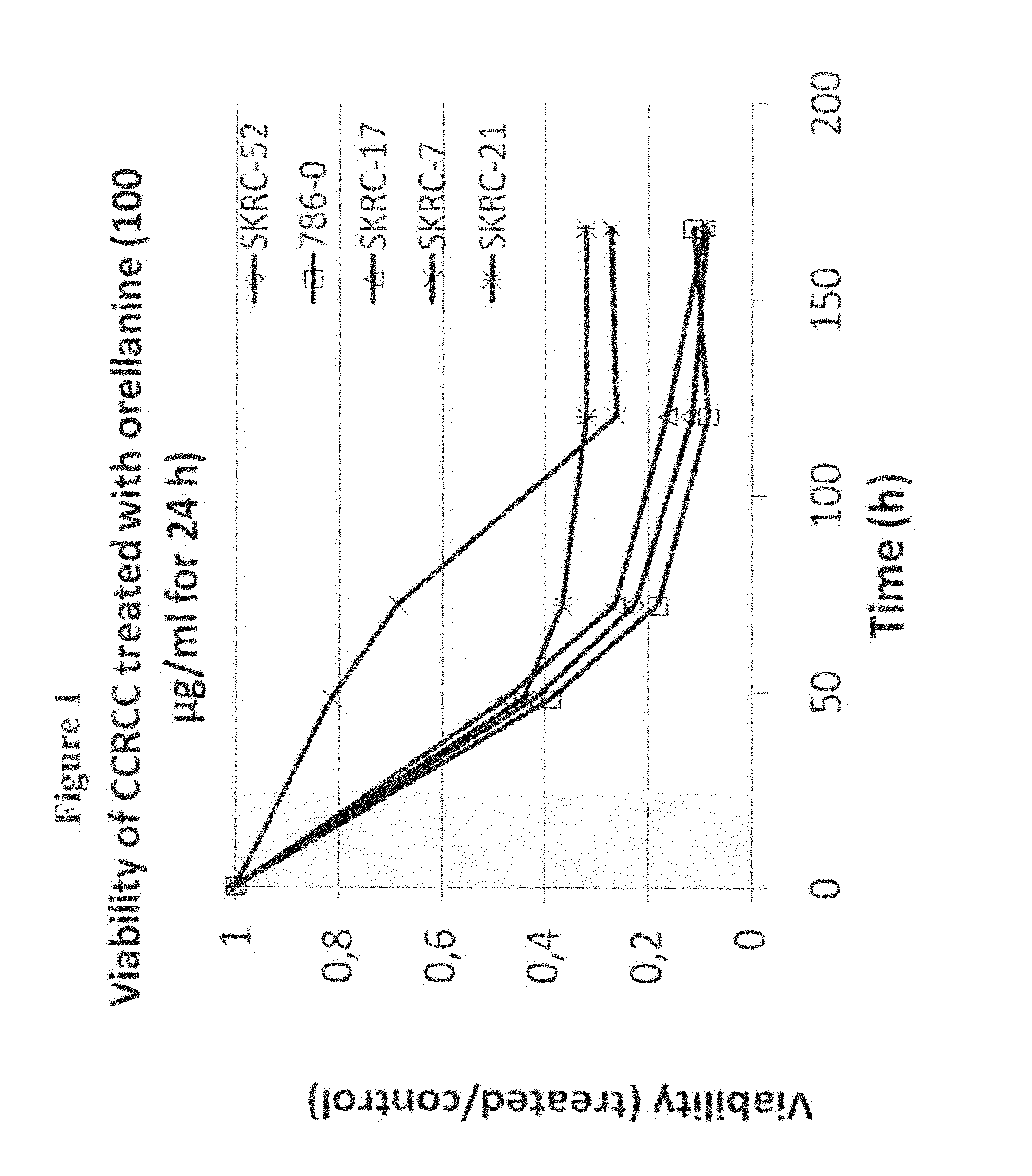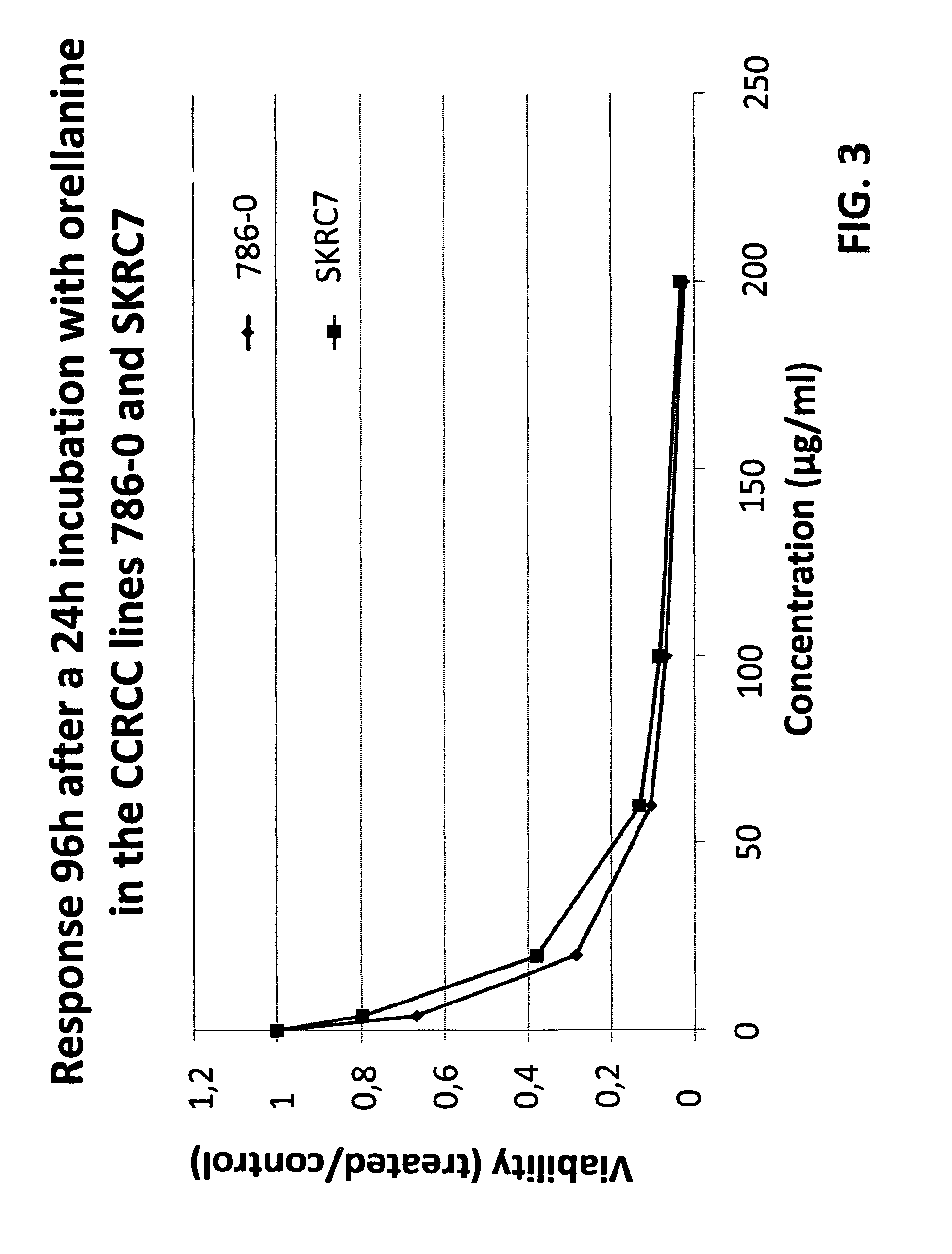Treatment of renal cell carcinoma
a renal cell carcinoma and treatment technology, applied in the field of cancer treatment, can solve the problems of cancerous or malignant tumors, and cancerous or malignant tumors, and achieve the effect of rapid growth and rapid growth
- Summary
- Abstract
- Description
- Claims
- Application Information
AI Technical Summary
Benefits of technology
Problems solved by technology
Method used
Image
Examples
example 1
Extraction and Isolation of Orellanine from Cortinarius Mushrooms
[0094]A. Polar method: 2 g of dried Cortinarius mushroom were powdered and then extracted with 50% methanol for 24 h at 25° C. The mixture was centrifuged, and the supernatant removed to a final volume of 5 ml. Upon repeated addition of 5 vol of cold methanol, a precipitate formed which was discarded until a clear solution formed. The solvent was evaporated, the residue dissolved in water and apolar substances removed by extraction with petroleum ether. The polar phase was loaded onto a Sephadex column and eluted with 50% ethanol. The resulting fractions were chromatographed on thin layer cellulose, eluting with butanol:acetic acid:water (3:1:1). Orellanin was identified as a fluorescent band at Rf 0.68.
[0095]B. Apolar method: 4 g of powdered Cortinarius mushroom were refluxed for 24 h in diethyl ether, and the solvent was discarded. The residue was refluxed in methanol followed by solvent evaporation and washing with ...
example 2
Synthesis of Orellanine
[0096]Orellanine was synthesized from commercially available 3-hydroxypyridine essentially as described by others. (Tiecco M, Tingoli M, Testaferri L, Chianelli D and Wenkert E: Total synthesis of orellanine, the lethal toxin of Cortinarius orellanus Fries Mushroom. Tetrahedron 42, 1475-1485 (1986))
example 3
Orellanine has a Specific Toxic Effect on Human Renal Cell Carcinoma Cells in vitro
Background and Methodology.
[0097]Cells harvested from 5 different human renal cell carcinomas (SKRC-52, 786-0, SKRC-17, SKRC-7 and SKRC-21), representing both mother tumors and metastatic growths, were cultured under standard conditions. When approximately 70% confluent and in rapid growth, the cells were exposed to medium containing Orellanine (400 μM) for 24 h. Then the medium was changed back to regular, complete medium and the cells were observed for another six days.
Results and Comments.
[0098]The effect of the described Orellanine treatment of the cells is illustrated in FIG. 1. It is evident from the figure that Orellanine was highly toxic to all the tested cell types. Moreover, the toxicity was not affected by removal of Orellanine from the culture medium after the initial exposure. This suggests that Orellanine accumulates in the cells and remains there even when no extracellular Orellanine is...
PUM
| Property | Measurement | Unit |
|---|---|---|
| concentration | aaaaa | aaaaa |
| enantiomeric excess | aaaaa | aaaaa |
| enantiomeric excess | aaaaa | aaaaa |
Abstract
Description
Claims
Application Information
 Login to View More
Login to View More - R&D
- Intellectual Property
- Life Sciences
- Materials
- Tech Scout
- Unparalleled Data Quality
- Higher Quality Content
- 60% Fewer Hallucinations
Browse by: Latest US Patents, China's latest patents, Technical Efficacy Thesaurus, Application Domain, Technology Topic, Popular Technical Reports.
© 2025 PatSnap. All rights reserved.Legal|Privacy policy|Modern Slavery Act Transparency Statement|Sitemap|About US| Contact US: help@patsnap.com



